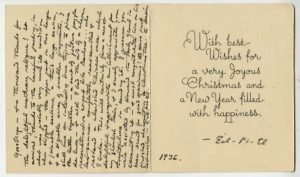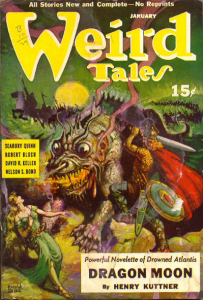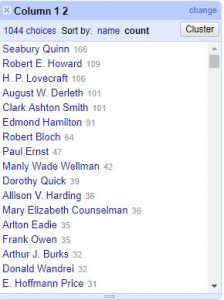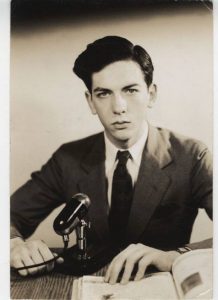Contributed by:
Maristella Feustle
Music Special Collections Librarian
Willis Conover’s correspondence in the mid-1930s with horror/sci-fi writer H.P. Lovecraft is well known in sci-fi circles thanks to the book Conover published in the 1970s, Lovecraft at Last. The original letters in Lovecraft’s own handwriting reside in the UNT Music Library’s Willis Conover Collection, alongside the hundreds of boxes of recordings and papers related to Conover’s career as a jazz broadcaster, for which he is best known.

a Christmas card from H.P. Lovecraft to Willis Conover, 1936

A representative WT cover

Listing split into columns in OpenRefine

Weird Tales authors: Text facet and sort by count
Clifford Ball (6)
Arthur Burks (32)
August Derleth (138, as lead author or co-author)
Robert Bloch (64+)
Howell Calhoun (3)
Henry Kuttner (31)
Stanton A. Coblentz (19)
Carl Jacobi (18)
H.P. Lovecraft (126, some under pseudonynms)
C.H. Craig (8)
Donald Wandrei (37)
David H. Keller (24)
E. Hoffman Price (35)
Earl Peirce, Jr. (7)
Forrest Ackerman (1, with C.L. Moore)
George R. Hahn (1)
Jack Williamson (17)
John Russell Fearn (1)
Otto Binder (7, with Earl Binder)
Paul Ernst (47)
Seabury Quinn (166)
In a 1933 letter, Conover’s father, Willis Conover, Sr., tells his son, “I must say that you are some letter writer.” Just a few years later, Willis Conover, Jr. would prove how true that observation was. Conover the writer was overshadowed by Conover the broadcaster, as Conover left his work as an English major at Salisbury State Teachers College after one year to be a radio announcer. However, Conover continued to write prolifically for the rest of his life, including newspaper and magazine articles, liner notes, song lyrics, and puns and limericks to amuse himself. Therefore, understanding Conover as a young writer lends important context to his career in radio which followed.

Willis Conover in the late 1930s








Leave a Reply